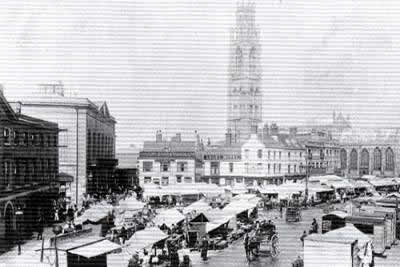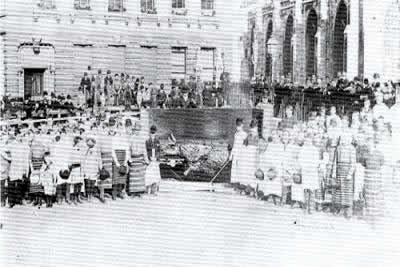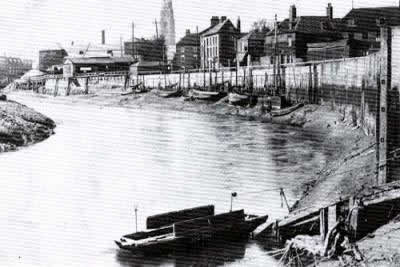BOSTON IN THE 16th AND 17th CENTURIES
In the mid-16th century Henry VIII closed the friaries in Boston. However Boston continued to be a busy little town. However Boston was not made a borough until 1545 when King Henry VIII granted it a charter (a document giving the townspeople certain rights). Furthermore from 1552 Boston sent 2 MPs to parliament. Boston Grammar School was founded in 1555.
Nevertheless in the 16th century Boston was much less important than it had been in the 13th century. The wool trade had almost stopped by 1500. The main trade from Boston was a coastal trade. (In those days it was easier to transport goods by water than by land and many commodities were shipped around the coast of Britain).
In the mid 16th century a writer named John Leland described Boston thus: (I have changed his words slightly to make them easier to read) 'The greatest and chief part of the town in on the east side of the river, where there is a fair market place and a (market) cross with a square tower.'
Leland said the Church of St Botolph was: 'so risen and adorned that it is the chief (church) of the town and for a parish church is the best and fairest in all Lincolnshire.'
During the 16th and 17th centuries the population of Boston continued to grow. (This was despite outbreaks of plague in 1587-88, 1603 and 1625). Maud Foster drain was dug in the mid-16th century. Then in 1604 James I granted Boston a new charter.
In 1607 a group of Puritans from the Gainsborough area, led by William Brewster, attempted to escape to Holland from Boston. At the time such 'emigration' was illegal but they bribed a captain to smuggle them on board a ship. However he betrayed them to the authorities before they could set sail. Nevertheless most of the Puritans were soon released and the next year they escaped in a ship from the Humber.
BOSTON IN THE 18th CENTURY
The writer Daniel Defoe visited Boston in the 1720s and he was impressed. He called it 'large and populous'. However Boston only really began to revive in the late 18th century when Holland Fen was drained. The newly drained land was rich and fertile and soon Boston began to 'export' cereals from the area to London.
In 1794 the River Slea was made navigable from Sleaford to the Witham, which increased the amount of traffic travelling through Boston. The Grand Sluice in Boston opened in 1766.
In 1713 a charity school opened in Boston. It was called the Blue Coat School because of the colour of the uniforms. A new Customs House was built in Boston in 1725. Fydell House was built in 1726 by William Fydell who was mayor of Boston 3 times.
In 1776 an Act of Parliament formed a body of men called Commissioners with power to light the streets of Boston and to appoint watchmen to patrol the streets at night.
In 1774 Boston gained its first bank and in 1795 a dispensary was opened where the poor could obtain free medicines.
BOSTON IN THE 19th CENTURY
In 1801 Boston had a population of 5,926. By the standards of the time it was quite a large market town.
In the early 19th century the coastal trade to and from Boston continued to flourish. Then in 1884 new docks were built downriver of the town which greatly boosted business. Meanwhile Maud Foster Mill was built in 1819.
Although Boston was really a market town there was some industry in the 19th century such as making farm implements and in the later 19th century a label making industry.
Furthermore there were some improvements to Boston in the 19th century. From 1825 Boston had gas light and a waterworks company was formed in 1845. The railway reached Boston in 1848. A volunteer fire brigade was formed in 1855. Also in 1855 a Corn Exchange was built in Boston.
|




